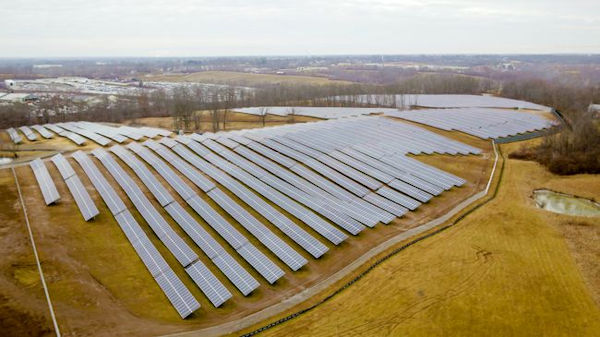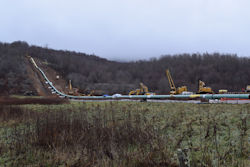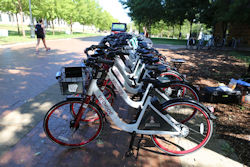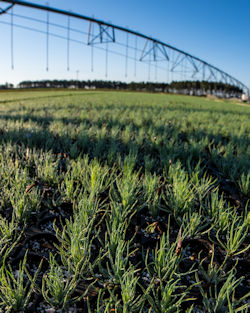SEJournal Online is the digital news magazine of the Society of Environmental Journalists. Learn more about SEJournal Online, including submission, subscription and advertising information.
 |
 |
| Solar energy is a bright spot for the region, but southern states meet only a tiny fraction of their energy needs with solar installations. And some criticize utility-scale solar farms, like the one in Kenton County, Kentucky, above, calling instead for more rooftop solar. Photo: Duke Energy. Click to enlarge. |
Covering Your Climate: Why the South Lags on Staving Off Crisis
This Society of Environmental Journalists’ special report — “Covering Your Climate: The South” — is the second in a series designed to help journalists of all kinds cover the impacts of climate change in their region, and to report on actions taken to mitigate its worst effects and preparations for what can’t be stopped. Below is part three of the special report, a tipsheet with a closer look at climate mitigation in the South. In the coming weeks, we’ll also publish an additional tipsheet on climate adaptation and a resource toolbox. Meanwhile, check out a backgrounder and an additional tipsheet on impacts. The project is distributed through SEJournal and the independent, nonprofit media organization Southerly, which covers the intersection of ecology, justice and culture in the American South. Southerly's Lyndsey Gilpin served as regional editor for this special report.
By Elizabeth Ouzts
 |
| Construction in West Virginia on the 600-mile Atlantic Coast Pipeline, which before it was cancelled in 2020, was slated to cart natural gas from West Virginia to North Carolina. Photo: Lyndsey Gilpin. Click to enlarge. |
The region of the United States with the most at stake economically and ecologically when it comes to the climate crisis has been, in many ways, the slowest to act to stave it off.
Scientists are clear on what needs to happen to avoid the worst impacts of a warming planet: greenhouse gas pollution must be cut to zero by mid-century. Achieving that target means abandoning fossil fuels and powering the electric grid with carbon-free sources like wind and solar, and converting all manner of vehicles to run on electricity.
Progress toward this clean energy economy is often called “mitigation.” And the South has taken some steps toward it. But the region lags behind many other parts of the country for a confluence of reasons: the capture of state government by conservative politicians, the power of monopoly utilities and the challenges of cutting pollution from automobiles in a sprawling region.
There are signs these barriers are beginning to crack. The question is how quickly they will crumble.
Politics of the climate crisis
With few exceptions, state governments in the South are run by the GOP, the party that has spent over a decade denying climate science. That effort has trickled down to Republican voters, while a misinformation campaign by the fossil fuel industry, and the decline of local news to inform people, has seeded doubt on the issue across voters of all stripes.
According to 2018 data from Yale and George Mason universities, Democrats in the South are about twice as likely as Republicans to be worried about global warming. In seven states in the region, fewer than half of voters believe that most scientists think global warming is happening.
Denial of the crisis has been particularly durable in coal-producing West Virginia and Kentucky — where a majority don’t believe global warming is caused by human activity.
To the extent the South has begun a slow
wean off fossil fuels, it mostly hasn’t been
in the name of solving the climate crisis.
To the extent the South has begun a slow wean off fossil fuels, it mostly hasn’t been in the name of solving the climate crisis.
According to the Sierra Club’s Beyond Coal campaign, over 240 coal units have shuttered in the region since 2010, about a third of those retired nationwide. Those closures were driven by the worsening economics of coal compared to fossil fuel gas, aka natural gas (and to some extent, renewables), thanks in large part to regulations on air pollutants other than greenhouse gases.
Ocean drilling for oil and gas has remained confined to the western Gulf, despite attempts by both the Obama and Trump administrations to expand it to the Atlantic. The blow to additional drilling came after fishers, surfers and tourism-based businesses rallied against unsightly rigs and the threat of toxic spills like the BP disaster — not their connection to rising seas and flooded coastlines.
Perhaps the biggest win for climate activists in 2020 was the defeat of the 600-mile Atlantic Coast Pipeline, slated to cart fossil fuel gas from West Virginia to North Carolina. To be sure, its demise came after dogged grassroots organizing that included warnings about methane, the heat-trapping pollutant many times more potent than carbon dioxide. But investors Duke Energy and Dominion Energy ultimately dropped the project over non-climate-related legal challenges.
Sprinkling of climate breakthroughs
Still, there has been some landmark legislation in parts of the region.
Virginia — unique in the 13-state region for having both a Democratic governor and a Democratic legislature — passed the Clean Economy Act, which requires its two major utilities to convert to 100% clean energy by 2050.
In 2018, North Carolina's Democratic governor, Roy Cooper, issued an executive order to curb the state’s greenhouse gas emissions 40% from 2005 levels by 2025. His administration later followed that up with a plan to reduce greenhouse gas emissions from utilities 70% by 2030.
 |
| A shared bike program in Fayetteville, Arkansas, where the city has set up a network of commuter bike trails to help curb pollution. Photo: City of Fayetteville. Click to enlarge. |
Dozens of cities from Houston to West Palm Beach, Florida, have also taken climate action. One standout: Nestled in the foothills of the Ozarks, Fayetteville, Arkansas, plans to power all of its municipal operations with solar and other renewable energy sources in the next decade. A network of commuter bike trails within a half mile of all 90,000 residents and a bike-share program will help it curb community-wide pollution 40% over the same time frame.
Most of these efforts have been decidedly Democratic. But polling shows the partisan gap on climate is narrowing, especially as its impacts become harder to ignore. Led by a Republican mayor, Miami city government aims to become carbon neutral by 2050. In 2019, Florida Gov. Ron DeSantis broke with his predecessor, now-Sen. Rick Scott, who famously banned the terms “climate change” and “sea level rise” from administrative documents.
Entire nonprofits have sprung up to convince other conservative politicians to follow suit. They include republicEn, founded by former South Carolina U.S. Rep. Bob Inglis, who lost his Republican primary partly because he accepted climate science.
Other factors are influencing the Southern electorate. Moderate and liberal voters are increasingly migrating to the region.
The South also has a large percentage of people of color, who are more likely than white people to support action to stem the climate crisis. As groups like Fair Fight, the nonprofit founded and run by former Democratic gubernatorial candidate Stacey Abrams, work to reverse decades of institutionalized voter suppression of these communities, political will for climate action could continue to grow.
Indeed, Abrams’ strategy bore notable fruit in 2020, when traditionally-red Georgia voted for President-elect Joe Biden and two Democrats for U.S. Senate, giving Democrats control of the White House and Congress.
Monopoly utility model under pressure
In the South, monopoly utilities still have a grip on the electricity markets and wield enormous political power.
The utility business model depends on building large, centralized, fossil fuel and nuclear power plants, paid off over time by captive ratepayers. Vertically integrated companies like North Carolina-based Duke Energy and Georgia-based Southern Company control generation, distribution and the sale of electrons. By definition, this model crowds out competition, which has stifled the growth of renewable energy.
The exceptions in the region help prove the rule.
Texas has more wind turbines than any other state in America, supplying nearly a fifth of its electricity, according to the American Wind Energy Association. It’s the only state in the region that’s fully deregulated.
West Virginia, which has a competitive wholesale market, has the second most wind energy with over 700 megawatts, enough to power nearly 160,000 homes.
Virginia and North Carolina are the first states in the region with offshore wind farms under development; it’s no coincidence that both projects are part of the PJM wholesale competitive marketplace — where customers other than Duke can buy the energy they’ll produce.
The rapidly developing Southern states also
lag when it comes to energy efficiency. All
but one rank in the bottom half of states.
The rapidly developing Southern states also lag when it comes to energy efficiency. All but one rank in the bottom half of states by the American Council for an Energy-Efficient Economy, measured by whether they’d passed a range of polices, from appliance standards to building codes.
The blame for this low standing can be laid partially at the feet of monopoly utility companies, who have little incentive to help customers buy less of their product. (The building industry also deserves responsibility.) As millions of Southerners struggled to pay their utility bills during the pandemic, the problem of energy security has been laid bare, since poor people tend to live in housing that is least energy efficient.
Solar’s upward swing
To be sure, solar energy is a bright spot for the region. North Carolina has the second most solar energy in the country, with 6.4 gigawatts, according to the Solar Energy Industries Association. Florida and Texas are close behind.
Add in Georgia, South Carolina and Virginia, and the region’s top six states have nearly 23 gigawatts installed, a quarter of the nation’s total and enough to power nearly 3 million homes.
 |
| Pine seedlings at a farm in Fort Valley, Georgia, in 2019. Photo: USDA/Lance Cheung. Click to enlarge. |
Yet none of these states meets even a tenth of their energy needs with these installations. Their output pales next to California, the country’s clear solar leader, which has 28 gigawatts installed and enough to meet more than a fifth of its electricity needs. The bottom seven states in the South have just under 1.5 gigawatts of solar combined.
What’s more, the vast bulk of this solar capacity is in the form of utility-scale solar farms, rows and rows of ground-mounted panels on leased farmland that are at the mercy of the utility they connect to. Experts say unleashing solar power’s full potential means greatly expanding distributed rooftop solar panels too.
Increasingly, investors are demanding that utility companies make plans for the climate crisis. Of the five largest electric utilities that have committed to a zero-carbon future by 2050, three are located in the region: Dominion Energy, Duke Energy and Georgia-based Southern Company.
But so far, only Dominion has backed up its commitment with a credible plan to meet it — largely because it was forced to by law. Both Duke and Southern Company have been roundly criticized for planning to expand their use of fossil fuel gas on their paths to net zero.
As Duke and Southern Company continue to plan a spate of new gas units in the next decades but slow-walk renewable energy development, there are growing calls across the political spectrum to break up their monopolies. (The companies themselves are even exploring the creation of their own energy trading platform, though critics say the forum would fall far short of true competition.)
Still, most experts say competition in and of itself can’t produce the 100% clean energy transition scientists say is necessary to avoid the worst impacts of climate change, and complete deregulation could bring downsides for consumers.
No matter what, the future of the utility business model will have huge implications, especially in the absence of national climate policy. Many cities with aggressive clean energy goals get their electricity from a monopoly utility. Forward-thinking policy in, say, Georgia, could push a multi-state utility like Southern Company to provide clean energy in Mississippi and Alabama.
Challenge of the transportation sector
Made up of rural and suburban landscapes interspersed with mostly sprawling cities, the South faces an enormous challenge in cutting pollution from the transportation sector, the largest source of greenhouse gases in the country and in most individual states in the region.
(Coal and gas power plants still edge out transportation in the region overall, largely because of coal-producers Alabama, Arkansas, Kentucky and West Virginia.)
According to the National Highway Administration, Southerners drive nearly 11,500 miles yearly on average — 16% higher than the national rate and more than twice the miles logged by New Yorkers.
Public transit tends to be subpar and, not
coincidentally, disproportionately used by
people of color. … Still, many of the same
communities also have ambitious plans.
Public transit tends to be subpar and, not coincidentally, disproportionately used by people of color. Most rankings of major cities by the quality of their public transportation systems put cities like New Orleans, Charlotte, South Carolina and Tampa, Florida at or near the bottom.
Still, many of the same communities with bold climate goals also have ambitious plans to improve public transit and provide alternatives to driving.
Atlanta is finally expanding its 40-year-old subway system. South Florida’s Tri-Rail is gaining more ridership. Orlando, Florida has a network of bike and moped sharing programs that will complement a planned high speed rail bound for Miami, among other initiatives, and it’s determined not to be derailed by the global pandemic.
“Even with COVID, Orlando is going to be moving more toward a greener future,” Chris Castro, director of sustainability and resilience for the city, told Grist last summer.
Like many energy policy leaders, Castro also wants to help proliferate electric vehicles; his city just spent “about a million dollars” on charging stations for plug-ins. Utilities and states throughout the region are making similar investments, especially with the help of their share of the Volkswagen settlement.
Virginia is using nearly all of its windfall for charging infrastructure and electric buses. These efforts, combined with advancing technology and falling prices, are starting to pay off: Texas and Florida both saw some of the nation’s highest sales of electric vehicles in 2018.
The question of forests
Building off a long history of growing pine plantations for the forest products industry, the South has become the world’s largest supplier of wood pellets, compressed bits of wood burned in place of coal in overseas power plants.
Buoyed by international subsidies, these pellet mills not only create air pollution in the predominantly Black and brown neighborhoods where they’re located, they also perpetuate an industrial forestry model that is making the climate crisis worse.
While the trees do absorb carbon as they grow, the critics’ argument goes, cutting them down and burning them releases more pollutants into the atmosphere, especially in the critical short term.
Skeptics of industrial forestry don’t advocate abandoning forest products altogether. Instead, they propose allowing forests to naturally regenerate and then managing them for multiple uses, including timber, recreation and carbon sequestration. Trees could be selectively harvested and thinned. Landowners would derive income from ecotourism, logging and dividends under something like a carbon tax.
With 200 million acres of timberland across the region, more than anywhere else in the country, the South has a tremendous opportunity to lead the way on this mitigation strategy. So far, it’s doing the opposite.
Looking forward, there’s cause for optimism.
Biden ran on the strongest climate platform ever put forward by a presidential candidate, and with control of both the House and Senate, there’s more hope than ever before he can enact some of it through Congress.
Such federal climate policy may be limited by moderates of both parties. But it could at least reach corners of the region on the frontlines of the crisis where local political leaders are not acting.
And as the economic and ecological tolls of inadequate action become harder and harder to ignore, it will be up to towns, cities, community activists and others across the region to show examples of solutions and push for more robust change.
 |
Based in Raleigh, North Carolina, Elizabeth Ouzts covers the state’s clean energy transition for the Energy News Network, a role she’s held since 2016. Her writing has also been featured in Environmental Health News. A former director of communications for the nonprofit Environment America, Elizabeth brings nearly two decades of experience in environmental and energy policy to her reporting.












 Advertisement
Advertisement 



